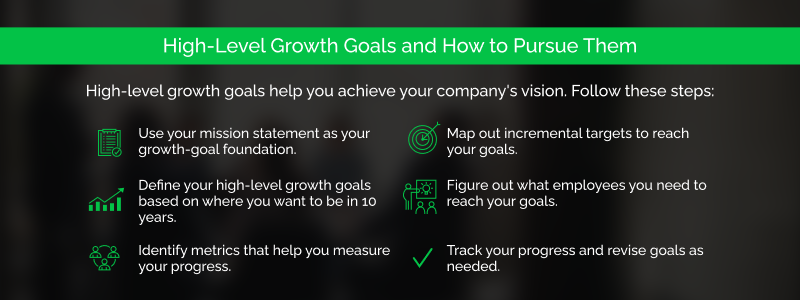High-Level Growth Goals and How to Pursue Them

High-level growth goals should guide your company's mission.

You want your business to grow, but how? For your business's growth to be sustainable, it must follow the type of growth you desire. You need clear high-level goals that define your objectives.
To reach those milestones , you need to break them down into smaller, incremental goals. This guide explains how to create high-level growth goals and outlines how to pursue them.
Mission statements: the foundation of high-level growth goals
The growth goals in a business need to align with the business's mission. To identify your high-level growth goals, start with identifying your core mission. Facebook's mission, for example, is to connect the world. Uber's goal is to provide reliable transportation for anyone, anywhere.
Your mission can even focus on the competition. Infamously, the founders of Nike articulated their vision as "crush Adidas". In other words, they wanted their new shoe company to be the biggest and most successful in the world. Mission statements should be short and simple, and they should form the foundation of growth goals for a business.
Defining your high-level growth goals
By their very nature, mission statements are aspirational and often vague. Your ultimate goal may be to connect the world, but you still need to create a to-do list for today. This is impossible without a map. To plot a path, set end goals and work backward.
To clarify your high-level growth goals, think about where you want you and the company to be in 10 years. Where do you see yourself and your company in 10 years? Do you want to still be running the company, or would you rather it be acquired while you move on to your next endeavor?
Think about how much you should grow your business. How big of a company do you want to run? How much growth can its market sustain? Is there a tipping point where growth becomes unsustainable?
There’s a risk the cost of the growth will outweigh the revenue generated. To be effective, growth goals need to be sustainable. This often means focusing on scalability as well as growth.
Identifying high-level-growth metrics
Once you've thought about these high-level questions, focus on numbers. How much revenue do you expect your company to generate? How many employees do you envision hiring?
Identify key performance indicators (KPIs) to track your growth. For instance, a company like Airbnb might use the number of rooms rented as a KPI when setting high-level growth goals. A streaming service might track the number of hours watched. A manufacturing company might monitor units sold.
The metrics used to measure growth goals in a business should correlate with revenue and retention goals. Depending on your business and its objectives, you may want to look at such metrics as customer lifetime value, monthly recurring revenue, number of new sales, or average value of sales. Figure out current metric, and then set high-level goals that match your 10-year plan.
Mapping out targets
After outlining your high-level growth goals, you’ll clearly see where you want to be in 10 years. Plot a path forward using incremental goals. To reach your 10-year goals, where do you need to be in five years? To reach that goal, where do you need to be in three, two, and one year's time? You’ll set goals for the next year, and then break them down even further, into monthly, weekly, and even daily goals.
Establishing support for your growth goals
You need quality team members to reach your growth goals. Outline when you need to hire new people, and understand your needs will change at different stages in your growth journey.
Decide the number and type of employees you’ll need. Estimate the cost of recruiting, hiring, and training new employees. Then, set retention goals. Make sure to incorporate employee attrition when creating cost estimates for new employees.
Revising your growth goals
Regularly review your progress. Are you meeting the short-term goals that set up successfully meeting long-term objectives? If not, you may need to revise your growth strategy. Tweak your short-term goals to see if you can still reach your high-level goals. Then, adjust your high-level goals as needed.
In other cases, you may hit short-term goals, but external factors may force revisiting high-level goals. Economic, social, or technological changes can affect your customers, your competitiveness, and how you do business. Stay nimble enough to adjust your goals as the world changes.
Growth goals are critical to success. You need to set targets that align with your organization's mission, and you need to break overall goals into manageable, incremental objectives . This requires the right team, and your sales personnel, in particular, play a critical role in helping your organization grow.
Many businesses hit sales-team roadblocks when they're trying to grow. Founders still occupy a sales role, and they struggle to build a sales team that meets their high-level growth goals.
We help businesses facing this challenge. MetaGrowth helps businesses hire, train, and maintain successful sales teams. To learn more, contact us today. Let's talk about how we can help you create an accountable, productive sales team – and you can focus on growing your business.
Written by
Joe Arioto
